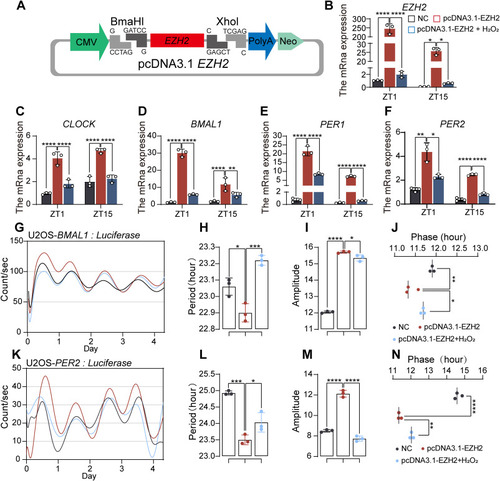Fig. 9
|
Overexpression of EZH2 Inhibits the Effects of ROS on the Circadian Clock (A) Construction of an EZH2 overexpression plasmid by inserting the EZH2 sequence downstream of the CMV promoter. (B–F) Following transfection with the EZH2 overexpression plasmid and 3-h H₂O₂ treatment, the mRNA levels of EZH2 and core clock genes (CLOCK, BMAL1, PER1, PER2) were measured. Each group was repeated three times, and t tests were used for significance analysis. The results indicated that ezh2 overexpression significantly increased the expression of core clock genes, whereas H₂O₂ treatment suppressed the increase in EZH2 expression and reduced core clock gene levels. (G) Comparison of U2OS::BMAL1-dLuc luminescence among three groups: EZH2 overexpression, EZH2 overexpression with H₂O₂ treatment, and the nonoverexpression control. (H–J) Analysis of the U2OS::BMAL1-dLuc luminescence cycle, phase, and amplitude revealed that H₂O₂ disrupted the effect of EZH2 overexpression, which normally shortened the cycle, increased the amplitude, and shifted the phase. (K) Comparison of U2OS::PER2-dLuc luminescence among the same three groups. (L–N) Analysis of the U2OS::PER2-dLuc luminescence cycle, phase, and amplitude revealed that H₂O₂ also disrupted the effects of EZH2 overexpression on U2OS::PER2-dLuc cycle shortening, amplitude increase, and phase shift. The experiments were repeated three times. (t tests were used for statistical analysis: ∗, p < 0.05; ∗∗, p < 0.01; ∗∗∗, p < 0.001; ∗∗∗∗, p < 0.0001). |

